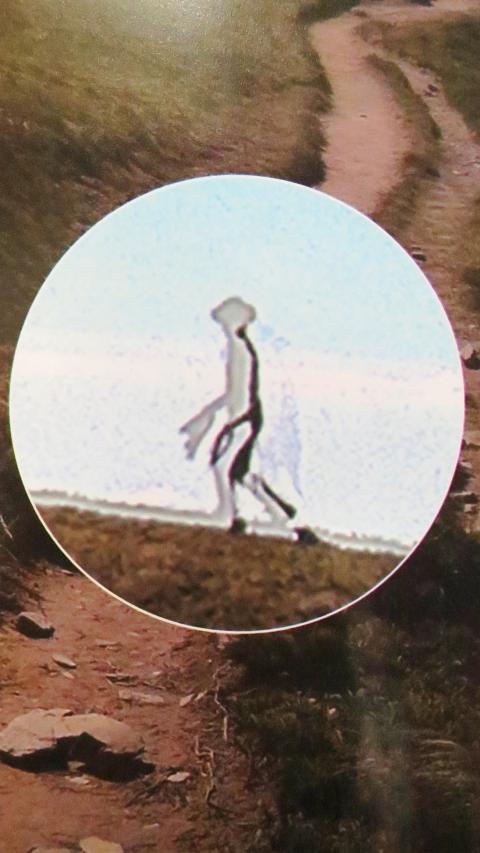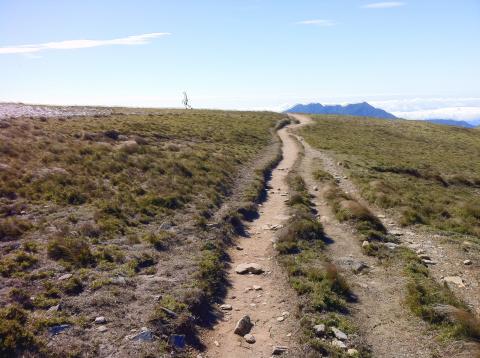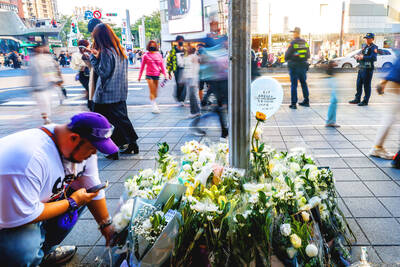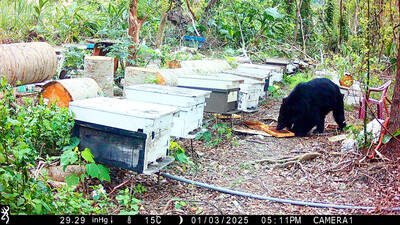A local UFO association has released a photograph taken at a high mountain lake which it says shows the image of an “alien being,” but skeptics say it may be a digitally edited or multiple-exposure photo.
The Taiwan UFOlogy Society (TUFOS) announced on Saturday that a photograph taken by a policeman at Jiaming Lake (嘉明湖) — located at an altitude of 3,310m on the southern section of the Central Mountains in Taitung County — shows what appears to be a large alien creature, with a transparent body and webbed hands, walking in the distance.
Due to its strange features, TUFOS executives say it does not look like a human being, but must have come from outer space.

Photo courtesy of the Taiwan Ufology Society
TUFOS chairman Huang Chao-ming (黃朝明) said the policeman gave them the photo, which was taken on his iPhone 4 mobile phone, for examination.
A close-up image of the so-called “alien being” shows double-exposure lines at the bottom. To determine whether the photo is genuine, TUFOS spent a year having experts on mobile phone technology, computer imagery and camera photography inspect the photo, but it has yet to make a conclusive finding.

Photo courtesy of the Taiwan Ufology Society
Some experts have said it may be a leftover image from the mobile phone’s flash memory that was superimposed on the scenery shot.
Huang said if it was a faulty superimposed image, why did the “alien being” just happen to be at the top of the mountain ridge line?
The photograph was taken by Chen Yung-huang (陳詠鍠), a policeman who went on a hiking trip to Jiaming Lake with his colleagues on May 14 last year.
Chen told Huang that he did not notice anything unusual, and only discovered the strange figure in the picture after coming down the mountains.
Chien Jung-tai (簡榮泰), an expert on photo image processing, was shown the photograph on Saturday. Chien initially said that a shaking motion when the shot was being taken might have produced the double lines in what might be a leftover image.
However, it was interesting to see that the double lines in the leftover image appear only in a small section of the photo, he said.
Chien also compared the pixel elements of the double lines below the “alien being” and the image above it, and said they do not differ much, adding that it does not appear to be an edited photo.
However, he said that if it were an “alien being,” then it should have a body structure and composition different from that of a human being.
Judging from the photo, the creature appears to have a huge body, but if it is transparent, it would not have an outline and a shadow, he said.
“If it was an alien being from another planet, with its own special biological structure, then we would be unable to interpret its shape and appearance, based on what we see from creatures on Earth,” he said.
When asked if the image might be caused by a superimposition of a leftover frame image from the mobile phone’s flash memory, Chien said that was a question that can only be answered by experts in optical imaging technology for flash memory devices.
Based on his experience with digital cameras and mobile phones, he said the probability of having a multiple-exposure image superimposed at just the right place in an outdoor scenery picture was low.
Huang said there have been reports from other countries of cameras capturing images of beings and objects that are invisible to the human eye.
He said TUFOS is planning to send the photo abroad for detailed examination, and it will seek the assistance of international UFO experts and organizations on the matter.

SHIPS, TRAINS AND AUTOMOBILES: The ministry has announced changes to varied transportation industries taking effect soon, with a number of effects for passengers Beginning next month, the post office is canceling signature upon delivery and written inquiry services for international registered small packets in accordance with the new policy of the Universal Postal Union, the Ministry of Transportation and Communications said yesterday. The new policy does not apply to packets that are to be delivered to China, the ministry said. Senders of international registered small packets would receive a NT$10 rebate on postage if the packets are sent from Jan. 1 to March 31, it added. The ministry said that three other policies are also scheduled to take effect next month. International cruise ship operators

HORROR STORIES: One victim recounted not realizing they had been stabbed and seeing people bleeding, while another recalled breaking down in tears after fleeing A man on Friday died after he tried to fight the knife-wielding suspect who went on a stabbing spree near two of Taipei’s busiest metro stations, Taipei Mayor Chiang Wan-an (蔣萬安) said. The 57-year-old man, identified by his family name, Yu (余), encountered the suspect at Exit M7 of Taipei Main Station and immediately tried to stop him, but was fatally wounded and later died, Chiang said, calling the incident “heartbreaking.” Yu’s family would receive at least NT$5 million (US$158,584) in compensation through the Taipei Rapid Transit Corp’s (TRTC) insurance coverage, he said after convening an emergency security response meeting yesterday morning. National

PLANNED: The suspect visited the crime scene before the killings, seeking information on how to access the roof, and had extensively researched a 2014 stabbing incident The suspect in a stabbing attack that killed three people and injured 11 in Taipei on Friday had planned the assault and set fires at other locations earlier in the day, law enforcement officials said yesterday. National Police Agency (NPA) Director-General Chang Jung-hsin (張榮興) said the suspect, a 27-year-old man named Chang Wen (張文), began the attacks at 3:40pm, first setting off smoke bombs on a road, damaging cars and motorbikes. Earlier, Chang Wen set fire to a rental room where he was staying on Gongyuan Road in Zhongzheng District (中正), Chang Jung-hsin said. The suspect later threw smoke grenades near two exits

The Forestry and Nature Conservation Agency yesterday launched a gift box to market honey “certified by a Formosan black bear” in appreciation of a beekeeper’s amicable interaction with a honey-thieving bear. Beekeeper Chih Ming-chen (池明鎮) in January inspected his bee farm in Hualien County’s Jhuosi Township (卓溪) and found that more than 20 beehives had been destroyed and many hives were eaten, with bear droppings and paw prints near the destroyed hives, the agency said. Chih returned to the farm to move the remaining beehives away that evening when he encountered a Formosan black bear only 20m away, the agency said. The bear